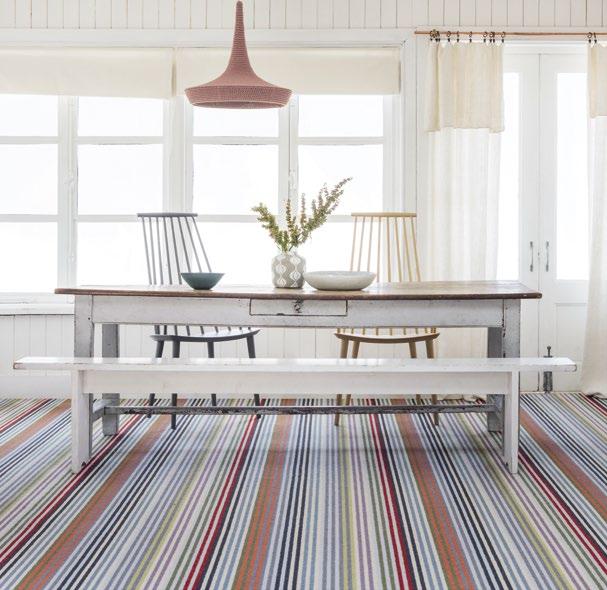
7 minute read
INTERIORS
www.crucial-trading.com www.alternativeflooring.com
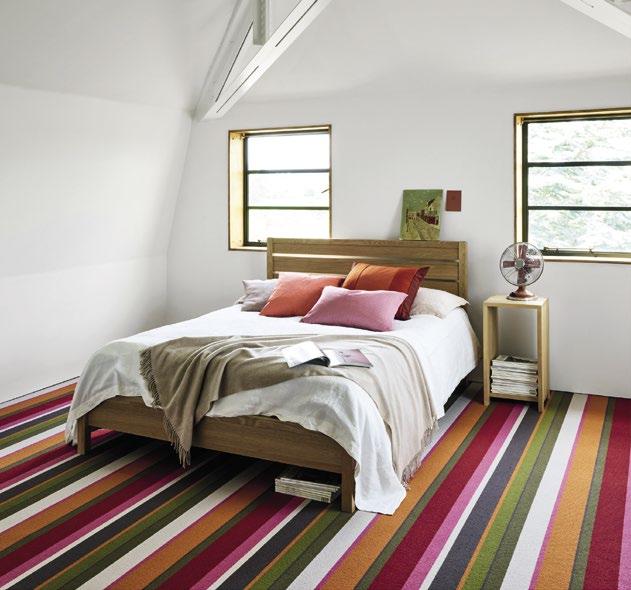
SASSYSTRIPES
Stripes are going to be featuring heavily in our interiors this year. They’re fun and playful and can liven up our homes. They adorn the Mills and Kinsella showroom, there’s so much choice; from the stunning stair runners and rugs of Roger Oates and Off The Loom, to the sensational Mississippi and Audrey carpets by Crucial Trading. Fabrics and wallpapers are no different, with Cole and Son having an entire collection full of striped wallpapers and Jane Churchill and Designers Guild both including some fashionable striped fabric designs in their latest spring collections.
Whether you prefer a neat little pinstripe or a big, broad line, stripes can bring structure and elegance to a space. They can be a statement in their own right, creating a focal point that diverts attention away from less desirable features. Vertical stripes help a ceiling to look taller by drawing the eye upwards, horizontal stripes give the opposite effect, making rooms seem wider and the ceiling lower. Strong, vibrant stripes give a small room a more spacious feel, narrower stripes make a space feel grander.
Stripes work exceptionally well when combined with patterns. Try striped curtains with a floral wallpaper or a floral headboard with striped bed linen. So long as the colours within the stripes and patterns complement each other, the scheme will co-ordinate and look balanced.
Alternatively, monochromatic stripes can be used to bring relief to a highly patterned scheme, breaking up the plethora of colour and giving the eye a rest, something more orderly on which to focus.
If black and white stripes are the main feature of your room, then accessorise with colourful vases, ornaments, sculptures or artwork. A bright pop of colour will be set off perfectly by the black and white background.
Stripes are a tool that can be used in any room, they never go out of fashion; but be careful in bathrooms where the look can become a bit New England. To prevent this, stay away from being too coordinated, mix your colours or use stripes of different proportions.
If you fancy being more daring, then combine stripes with other stripes. Layering different thicknesses and colours, some positioned with the stripes lying horizontally, some vertically, can be very effective, particularly in rooms where you want to
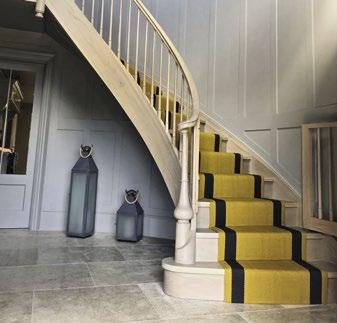
Rosie Kinsella Interior Designer 01604 751262 www.millsandkinsella.com
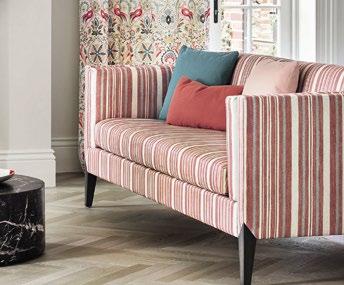
www.janechurchill.com be continually stimulated. Home offices, kitchens or playrooms are perfect for this treatment. However, in bedrooms, stripes are best used in softer tones where they will stimulate less and be more conducive to relaxing and winding down at the end of a hard day.
Stripes used on the floor will anchor a scheme. Whether your choice is a striped rug or carpet, choose the style and colour you like and then build the rest of the scheme around it. Striped carpets are still a relatively recent phenomenon, but you only need look at the lifestyle imagery featured in the advertisements of Crucial Trading, Roger Oates, Off The Loom and Alternative Flooring, to know how impactful they can be. Their awe-inspiring designs can be perfectly matched with neutral walls and simple furniture; or striking paintwork in deep colours.
Over the last couple of years we’ve seen a surge in interest in striped stair runners. They create a strong design statement as soon as you enter a house, adding colour,
texture and pattern. A broad stripe will help a staircase feel wider and any stripe leading up the stairs will help the stairwell feel taller and larger.
If you don’t have the stairs to support a runner, or they’re not of good enough quality to have the sides exposed, then consider a striped rug to make a similar statement. Whether it’s long and narrow to fit on the landing or hallway, or square or rectangular to suit the living or dining room, a rug is a simple way to deliver impact and colour in an otherwise ordinary space.
When dabbling with stripes for the first time, keep away from anything too complicated. If you’re unsure, maybe start with some paint that can be easily changed. Cover a wall in a two-tone stripe, with the top half a sightly lighter tone than the bottom half. This might not feel very adventurous but it’s a good way to take a tentative step towards a bolder scheme.

www.rogeroates.com

Next add a striped cushion or a striped piece of artwork and go from there. Layering up your room in a gradual way, will help to ensure that the finished result is coherent and most importantly, easy on the eye. It should also give you the confidence to try more daring ideas as you develop your look.
If you’re still not convinced, and prefer to keep your home neutral and minimalistic, then consider how each of your rooms makes you feel. Even paired back spaces could usually do with a little lift to stop them feeling flat and dull. Adding a small section of stripe could be the perfect way to achieve this. Try a single cushion, vase or book with a striped finish.
The stripes trend is timeless. It’s a classic look that will always remain fashionable. There are very few patterns that have such staying power so don’t be afraid to experiment and bring a stripe into your home!
Symbolism of Love
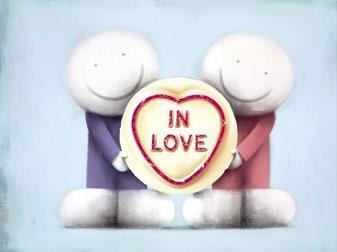
he romantic holiday of Valentine’s day, falling on February 14th, is the occasion to show that special someone just how much you love them. Some express their affection through flowers and chocolates, or opt for a delicious dinner or relaxing trip to the spa. In Italy, it’s customary for couples to receive ‘Saint Valentine’s Keys’, a symbol of inviting another to unlock your heart.
However, Valentine’s Day has not always been all about romance, only becoming associated with love in the 14th century, and the history of the celebration is fascinating. Its exact origins are cloudy, as there have been numerous notable Christian martyrs named Valentine who could have been commemorated through the creation of the holiday. One potential is a priest martyred in about 270CE, who was thought to have written a note to the daughter of his jailer, ending it with the now widely used phrase “from your Valentine.” Alternatively, a bishop may be responsible, who was said to have secretly officiated weddings between couples behind the emperor’s back to save husbands from being sent to war, thus connecting his day of remembrance with love.
Whatever the true origins of Valentine’s day, the occasion has grown to have its own traditions and symbols, including Cupid, the Roman god of love and desire. Mythology states that Cupid would shoot an arrow through a person’s heart to control their affections and who they fell in love with, unbeknownst to the victim. Birds also commonly feature on Valentine’s day cards, and this is theorised to be due to the coinciding of their mating season.
Lastly, and most abundant, is the symbol of the heart – the origins of why hearts are now integrally linked to love and Valentine’s are unclear, in the absence of an explanation, it could be related to the image of the joining of two halves.
Nevertheless hearts are a prominent feature on the holiday, and have crept their way into artwork depicting displays of affection and appreciation. Jenni Murphy’s limited edition print ‘Sparkly Love’ is a charming piece portraying a couple running up a hill, hand-in-hand, painting a heart into the night sky using a glittering sparkler. Mackenzie Thorpe is an artist who is no stranger to heart symbolism, featuring as a distinct characteristic in much of his artwork – ‘Hand in Hand’ is a new limited edition print illustrating lovers making their way through a field of heart-shaped flowers, plucking them as they go.
Doug Hyde is another artist with a variety of romantically-themed pieces; one of my favourites is the limited edition ‘Together In Love’, which incorporates a more modern Valentine’s token in the form of the Love Hearts sweets.
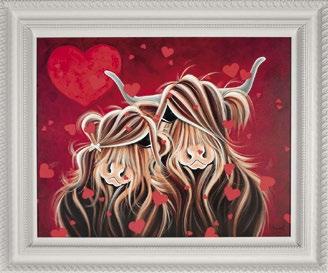
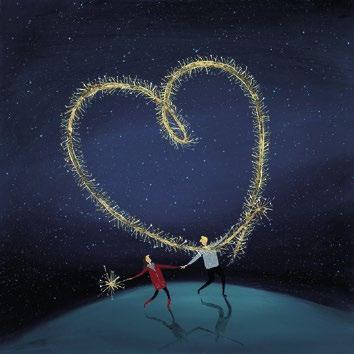
Gemma Davey Gallery Correspondent www.therosegallery.co.uk










